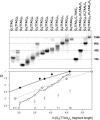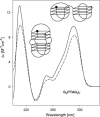Guanine tetraplex topology of human telomere DNA is governed by the number of (TTAGGG) repeats
- PMID: 16221978
- PMCID: PMC1253834
- DOI: 10.1093/nar/gki898
Guanine tetraplex topology of human telomere DNA is governed by the number of (TTAGGG) repeats
Abstract
Secondary structures of the G-rich strand of human telomere DNA fragments G3(TTAG3)n, n = 1-16, have been studied by means of circular dichroism spectroscopy and PAGE, in solutions of physiological potassium cation concentrations. It has been found that folding of these fragments into tetraplexes as well as tetraplex thermostabilities and enthalpy values depend on the number of TTAG3 repeats. The suggested topologies include, e.g. antiparallel and parallel bimolecular tetraplexes, an intramolecular antiparallel tetraplex, a tetraplex consisting of three parallel chains and one antiparallel chain, a poorly stable parallel intramolecular tetraplex, and both parallel and antiparallel tetramolecular tetraplexes. G3(TTAG3)3 folds into a single, stable and very compact intramolecular antiparallel tetraplex. With an increasing repeat number, the fragment tetraplexes surprisingly are ever less thermostable and their migration and enthalpy decrease indicate increasing irregularities or domain splitting in their arrangements. Reduced stability and different topology of lengthy telomeric tails could contribute to the stepwise telomere shortening process.
Figures








Similar articles
-
Tetraplex structure of fission yeast telomeric DNA and unfolding of the tetraplex on the interaction with telomeric DNA binding protein Pot1.J Biochem. 2007 Jan;141(1):57-68. doi: 10.1093/jb/mvm011. Epub 2006 Dec 11. J Biochem. 2007. PMID: 17158862
-
Characterization of parallel and antiparallel G-tetraplex structures by vibrational spectroscopy.Spectrochim Acta A Mol Biomol Spectrosc. 2006 May 15;64(2):495-503. doi: 10.1016/j.saa.2005.07.049. Epub 2005 Dec 27. Spectrochim Acta A Mol Biomol Spectrosc. 2006. PMID: 16384730
-
Conformational properties of DNA containing (CCA)n and (TGG)n trinucleotide repeats.Int J Biol Macromol. 2005 Jul;36(1-2):23-32. doi: 10.1016/j.ijbiomac.2005.03.005. Int J Biol Macromol. 2005. PMID: 15896838
-
G-quadruplexes incorporating modified constituents: a review.J Biomol Struct Dyn. 2014;32(3):477-511. doi: 10.1080/07391102.2013.775074. Epub 2013 Mar 25. J Biomol Struct Dyn. 2014. PMID: 23528013 Review.
-
Diverse effects of naturally occurring base lesions on the structure and stability of the human telomere DNA quadruplex.Biochimie. 2015 Nov;118:15-25. doi: 10.1016/j.biochi.2015.07.013. Epub 2015 Jul 15. Biochimie. 2015. PMID: 26188111 Review.
Cited by
-
In-silico prediction and observations of nuclear matrix attachment.Cell Mol Biol Lett. 2006;11(2):191-213. doi: 10.2478/s11658-006-0016-4. Cell Mol Biol Lett. 2006. PMID: 16847565 Free PMC article.
-
A guide to computational methods for G-quadruplex prediction.Nucleic Acids Res. 2020 Jan 10;48(1):1-15. doi: 10.1093/nar/gkz1097. Nucleic Acids Res. 2020. PMID: 31754698 Free PMC article. Review.
-
Circular dichroism and conformational polymorphism of DNA.Nucleic Acids Res. 2009 Apr;37(6):1713-25. doi: 10.1093/nar/gkp026. Epub 2009 Feb 3. Nucleic Acids Res. 2009. PMID: 19190094 Free PMC article. Review.
-
Epigenetics of a tandem DNA repeat: chromatin DNaseI sensitivity and opposite methylation changes in cancers.Nucleic Acids Res. 2008 Apr;36(7):2196-207. doi: 10.1093/nar/gkn055. Epub 2008 Feb 16. Nucleic Acids Res. 2008. PMID: 18281700 Free PMC article.
-
Emerging accessibility patterns in long telomeric overhangs.Proc Natl Acad Sci U S A. 2022 Jul 26;119(30):e2202317119. doi: 10.1073/pnas.2202317119. Epub 2022 Jul 18. Proc Natl Acad Sci U S A. 2022. PMID: 35858438 Free PMC article.
References
-
- Blackburn E.H., Greider C.W. Telomeres. Plainview, NY, USA: Cold Spring Harbor Laboratory; 1995.
-
- Cech T.R., Nakamura T.M., Lingner J. Telomerase is a true reverse transcriptase. A review. Biochemistry (Mosc) 1997;62:1202–1205. - PubMed
-
- Henderson E., Hardin C.C., Walk S.K., Tinoco I.J., Blackburn E.H. Telomeric DNA oligonucleotides form novel intramolecular structures containing guanine–guanine base pairs. Cell. 1987;51:899–908. - PubMed
-
- Choi K.-H., Choi B.-S. Formation of a hairpin structure by telomere 3′ overhang. Biochim. Biophys. Acta. 1994;1217:341–344. - PubMed
Publication types
MeSH terms
Substances
LinkOut - more resources
Full Text Sources
Other Literature Sources

